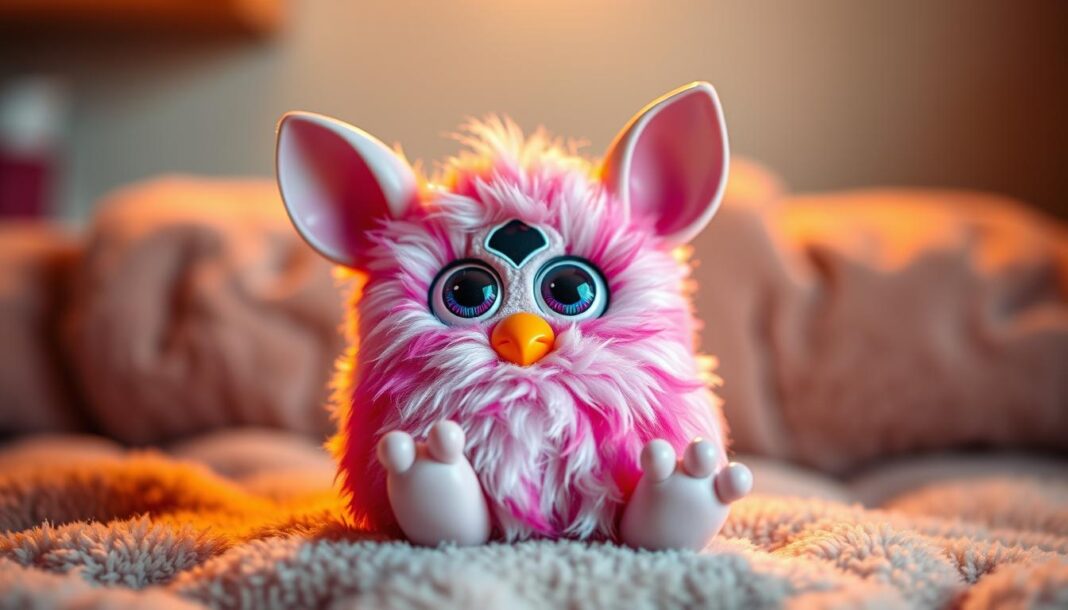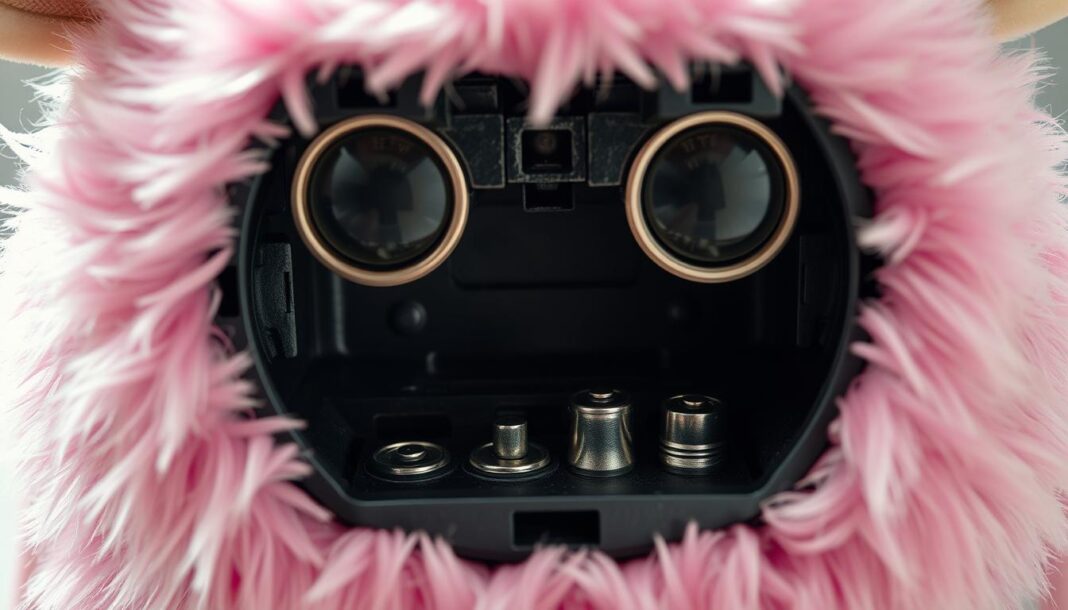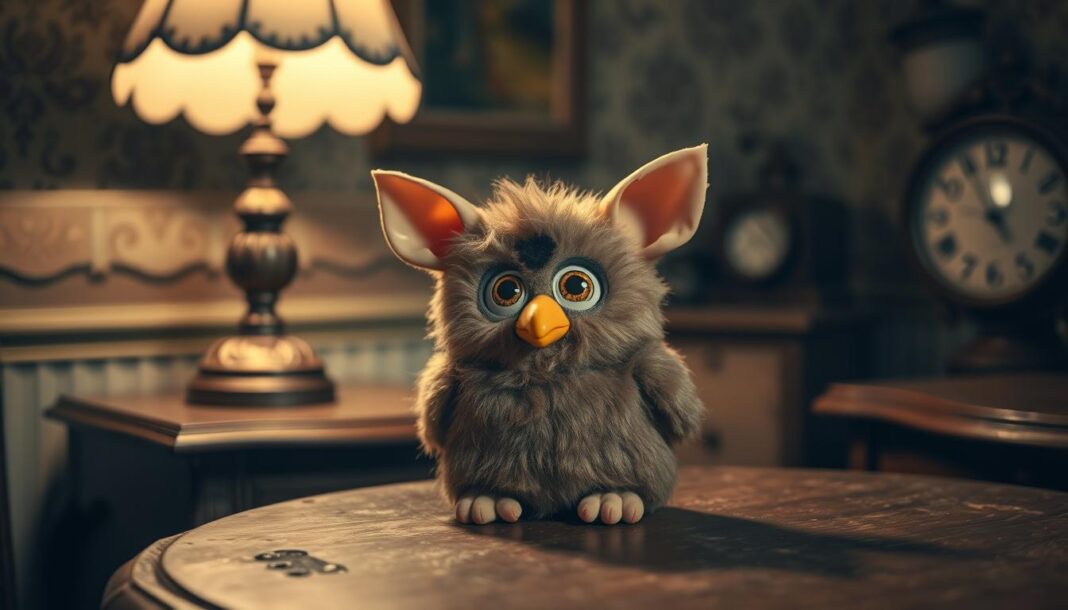In the late 1990s, a revolutionary electronic toy captured the hearts of children and adults alike. The 1998 Furby, created by Tiger Electronics, became an overnight sensation during the holiday season.
This interactive electronic pet represented a significant advancement in toy technology, offering adaptive learning and communication features that were groundbreaking for the time. Its popularity was unprecedented, with 1.8 million units sold in 1998 and over 40 million units sold during its initial production run.
The 1998 Furby phenomenon wasn’t just a flash in the pan; it maintained strong sales for years, becoming one of the defining toys of its generation. We will explore the complete story of how this fuzzy robotic companion captured hearts worldwide.
The Birth of a Cultural Phenomenon
In the late 1990s, a revolutionary toy was born, thanks to Dave Hampton and Caleb Chung. Their creation, the Furby, would go on to become a cultural phenomenon, captivating children and adults alike with its interactive features and adorable design.
Meet the Creators: Dave Hampton and Caleb Chung
Dave Hampton and Caleb Chung are the visionary inventors behind the Furby. Hampton brought his expertise in electronics and programming, while Chung contributed his background in toy design and animatronics. Together, they dedicated nine months to creating the initial concept and another nine months perfecting the design. Their collaboration resulted in something truly innovative – a fuzzy electronic pet that could interact with its owners.
From Concept to Toy Fair: The Nine-Month Journey
After developing the Furby concept, Hampton and Chung faced challenges in licensing their creation. They eventually partnered with Richard C. Levy, an experienced toy and game inventor who recognized the potential of their fuzzy electronic pet. Levy successfully brought the Furby concept to Tiger Electronics, where company executive Roger Shiffman immediately saw its market potential and acquired the rights. The Furby made its debut at the American International Toy Fair in 1998, generating significant buzz among industry professionals. The official release date of October 2, 1998, marked the beginning of what would become one of the most successful toy launches in history.
The Furby’s journey to success was marked by key milestones, including:
- The initial nine months of concept development
- Partnership with Richard C. Levy to license the Furby
- The debut at the American International Toy Fair in 1998
- The official release on October 2, 1998
The Original Furby 1998: Features and Functionality
The original Furby, launched in 1998, was a groundbreaking electronic toy that boasted an array of innovative features for its time. One of its most captivating aspects was its ability to interact with users and adapt to its environment, making it seem like a living creature.
Furbish: The Unique Language
The 1998 Furby introduced a unique language called “Furbish,” which consisted of 42 different words that could form hundreds of distinct phrases. This language was a key feature that set Furby apart from other toys. When first turned on, a Furby would speak entirely in Furbish, creating an immersive experience for its users.
The use of Furbish added to the toy’s mystique, making it seem as though Furby was communicating in its own language. This unique aspect was both fascinating and endearing to users, enhancing the overall interactive experience.
Adaptive Learning and Interaction
What made Furby truly special was its adaptive learning capability. As users interacted with it, Furby would gradually speak less Furbish and incorporate more English phrases, creating the illusion that it was learning from its owner. This adaptive behavior was achieved through sophisticated programming that responded to the toy’s usage patterns.
The interaction was not one-way; Furby could also respond to its environment and the actions of its users, making it a dynamic companion.
Sensory Capabilities and Movement
Furby’s capabilities extended beyond language; it was equipped with light sensors that detected changes in brightness and touch sensors that recognized when it was being petted or held. These sensors allowed Furby to react to its environment, further enhancing its interactive nature.
Additionally, Furby’s movement capabilities were impressive for its time, featuring ear wiggling, eye blinking, and mouth movement, all powered by a single motor with a clever camshaft gear assembly. This mechanical design enabled a range of expressions, making Furby seem more lifelike.
Inside the Furby: Technical Marvels of 1998
Beneath its soft fur, the original Furby concealed an intricate technological framework that was groundbreaking for its time. The 1998 Furby was a remarkable achievement in toy engineering, showcasing advanced intelligence and interactive capabilities.
The 6502 Microprocessor and Memory Capabilities
The Furby was powered by a 6502-style Sunplus SPC81A microcontroller, which boasted 80 KiB of ROM and 128 bytes of RAM. The original source code was written in assembly language for the 6502 microprocessor, a testament to the programming efficiency required to achieve such interactive behaviors with limited memory. This microcontroller, although differing from the original 6502 in its lack of the Y index register, was instrumental in enabling Furby’s complex functionalities.
One Motor, Endless Possibilities: The Mechanical Design
The mechanical design of the Furby was equally impressive, utilizing a single motor along with a clever system of cams and gears to produce multiple movements. These included eye blinking, ear wiggling, and mouth movement, creating a lifelike interaction that captivated users. The ingenuity of Tiger Electronics engineers was evident in how they managed to achieve such a range of motions with minimal hardware.
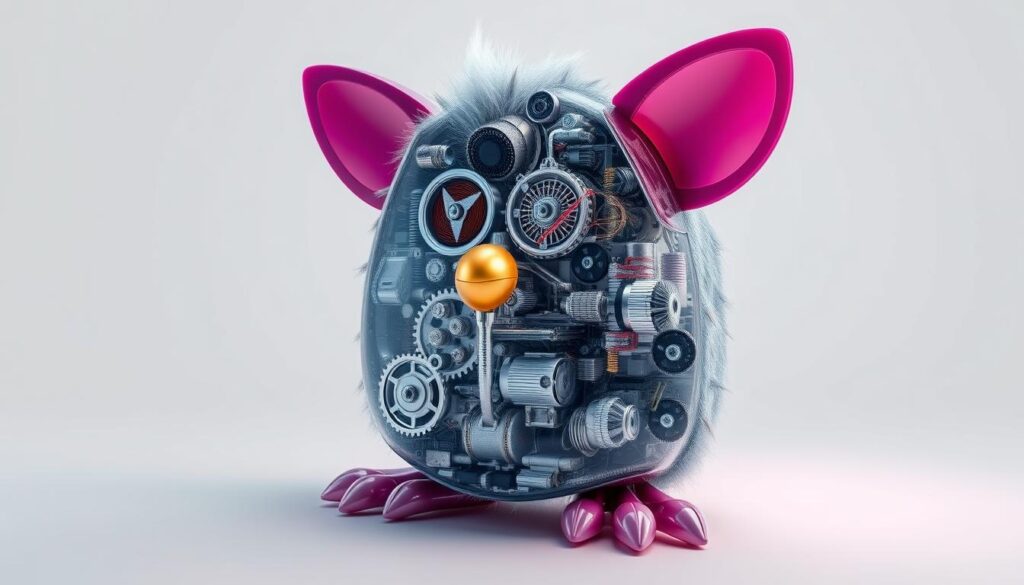
The Furby’s voice synthesis was another technical feat, achieved through the TSP50C04 chip from Texas Instruments. This chip implemented linear predictive coding to generate the Furby’s distinctive voice patterns and Furbish language, further enhancing its interactive capabilities. The combination of these technological elements resulted in a toy that was not only entertaining but also showcased significant intelligence for its time.
Furby Fever: The Holiday Season Rush of 1998
The 1998 holiday season was marked by an unprecedented craze surrounding Furby, a toy that was initially met with moderate interest but soon became the most sought-after gift of the season.
As the holiday period approached, the demand for Furby skyrocketed, leading to a significant shortage in supply. This imbalance between supply and demand triggered a series of events that would make Furby a defining toy of the decade.
From $35 to $300: The Resale Market Explosion
Initially retailing for a reasonable US$30-35, the overwhelming demand for Furby quickly outpaced supply, creating a secondary market where these toys sold for upwards of $100 and sometimes reaching $300 or more.
The resale market explosion was fueled by desperate parents seeking to fulfill their children’s wishes. Reports of Furbies selling for exorbitant prices in newspapers and early online auction sites became common, highlighting the intense popularity of the toy.
Production and Demand Challenges
Tiger Electronics, the manufacturer of Furby, struggled to meet the explosive demand. Production facilities worked around the clock but were still unable to satisfy the holiday rush.
The scarcity led to chaotic scenes at toy stores, with reports of shoppers lining up before dawn and even minor altercations breaking out as limited stock arrived. The Furby craze wasn’t just limited to children; adults and collectors joined the frenzy, further driving up prices.
This period of intense popularity continued through 1999, with the company selling a staggering number of units, establishing Furby as one of the defining toys of the decade.
The Many Faces of Furby: Colors and Special Editions
The 1998 Furby was released in a variety of colors, captivating collectors and enthusiasts alike. This diversity was a key factor in the toy’s success, offering something for everyone. The original Furby line featured an impressive array of 48 regular color combinations, giving collectors plenty of variety to choose from and encouraging multiple purchases.
Original Colors
The first era of Furby, which ran from 1998 to 2002, boasted 48 regular colors. Each Furby variant featured different colored fur, eye colors, and sometimes different voice pitches, creating over 1,000 unique possible combinations across the product line. Fans and sellers gave nicknames to the different Furbys, such as ‘Sunrise Furby,’ ‘Tuxedo Furby,’ ‘Snowball Furby,’ and ‘Bandit Furby,’ to differentiate them.
Special Editions
In addition to the regular colors, 22 special edition Furbys were released for holidays and special occasions. These included the highly sought-after Millennium Furby, Christmas Santa Furby, and Spring/Easter editions. Special editions added an extra layer of excitement for collectors and further expanded the Furby family.
Fresh New Look and Unreleased Models
The “Fresh New Look” line introduced subtle redesigns and new color combinations, keeping the product line feeling current and collectible throughout its run. Some of the rarest Furbys were the unreleased prototypes and models that never made it to market, including the Generation 9 and 10 designs that exist only as prototypes today. The most exclusive Furby was the “Bejeweled Furby,” sold through FAO Schwarz for $100,000, featuring genuine gemstones.
Furby Friends and Companions
The Furby universe grew with the introduction of new companions, each with unique features and personalities. These additions not only expanded the Furby family but also enhanced the interactive experience for users.
Furby Babies: The 1999 Follow-Up
In 1999, Tiger Electronics released Furby Babies, a smaller version of the original Furby. These Furby Babies had higher-pitched voices and were designed to be more approachable for younger children. Unlike their larger counterparts, they couldn’t dance, but they made up for it with an extended vocabulary and unique “Easter eggs” and games.
Furby Babies came in 24 different colors, all featuring white eyelashes and one of six different eye colors. They switched to speaking English more quickly than the original Furby, making them more relatable to children.
Shelby, Gizmo, and Other Furby Companions
The Furby universe further expanded with the introduction of Shelby in 2001, a clam-shaped companion with improved memory capabilities and its own unique personality. Shelby could communicate with both original Furbies and Furby Babies, and even had its own language called “Shelbish.”
The brand’s popularity also led to licensed character tie-ins, including Furby-style versions of popular characters like Gizmo from “Gremlins,” Yoda from “Star Wars,” and E.T. from the Spielberg film. These companions maintained the core interactive features that made Furby popular while introducing unique characteristics.
| Companion | Release Year | Unique Features |
|---|---|---|
| Furby Babies | 1999 | Higher-pitched voices, extended vocabulary, unique “Easter eggs” |
| Shelby | 2001 | Clam-shaped, improved memory, “Shelbish” language |
| Gizmo, Yoda, E.T. | Various | Licensed characters with Furby-style interactivity |
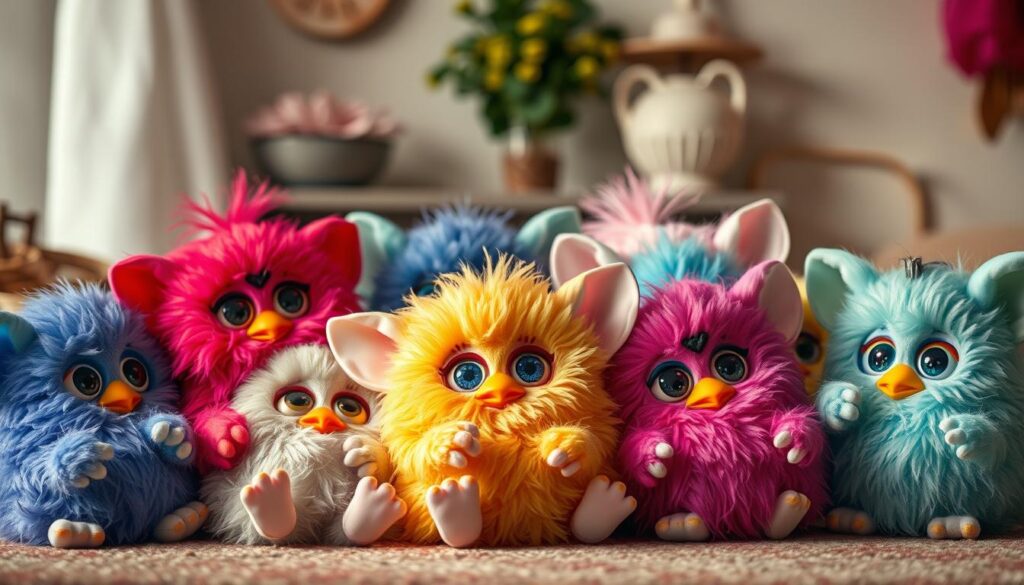
The Furby Mythology and Lore
The mythology surrounding the Furby was a key aspect of its appeal, making it more than just an electronic pet. The creators developed a rich backstory for these interactive creatures, establishing that they originated from a magical place called “Furbyland,” or “A-loh May-lah” in their native Furbish language.
Furbyland (A-loh May-lah): The Furby Origin Story
According to the official lore, Furbyland exists high in the sky on a cloud near the sun. The Furbies, being curious and adventurous, decided to leave their home by jumping down to Earth, where they could bond with humans. This origin story was a crucial part of the Furby’s charm, sparking imagination in children and adults alike. As one of the most iconic toys of 1998, the Furby’s backstory added a layer of depth to its interactive features.
Furby Personalities and Names
Each Furby was assigned one of 24 unique Furbish names, which it would reveal when its owner rubbed its tummy sensor three times and then petted its back. The personality traits of Furbies were carefully crafted to make them endearing companions – they were described as sensitive creatures with big hearts who enjoyed being tickled, hugged, and having their backs rubbed. As the Furby guide stated, “Furbys are very sensitive. They have big hearts.” This emotional connection was a key factor in the Furby’s popularity, making it a beloved companion for many.
The Furby’s language capabilities and interactive nature were central to its appeal. By speaking Furbish and responding to their environment, Furbies created a sense of companionship and interaction that was new and exciting for many users. The Furby’s ability to learn and adapt added to its charm, making it feel like a living creature rather than just a toy.
Furby’s Cultural Impact and Controversies
The Furby phenomenon of 1998 was not limited to the toy aisles; it permeated popular culture and sparked unexpected controversies. As one of the most popular toys of the year, Furbys became a cultural sensation, captivating children and adults alike with their interactive capabilities and seemingly intelligent behavior.
Security Concerns
In January 1999, the National Security Agency (NSA) issued a ban on Furbys entering their facilities due to concerns that the toys might record and repeat classified information. This decision was soon followed by similar bans at the Pentagon and Norfolk Naval Shipyard, creating a media sensation around the supposedly intelligent and potentially threatening toys. However, Roger Shiffman, the owner of Tiger Electronics, clarified that “Furby has absolutely no ability to do any recording whatsoever.” Dave Hampton, the creator, demonstrated that Furby’s microphone could only detect simple sounds, not record speech, alleviating concerns about its potential to capture sensitive information.
Media and Pop Culture
Furbys became fixtures in popular media, appearing in TV shows, commercials, and being referenced in cartoons, cementing their place in 90s pop culture. Their voice and ability to gradually introduce phrases made them a staple of many households. The popularity of Furbys led to their inclusion in museum exhibitions about technological innovation and 1990s cultural phenomena, highlighting their impact on society and their representation of the era’s fascination with intelligence in toys.
Global Furby: International Releases and Translations
As a global toy sensation, the Furby was released in numerous countries, captivating a wide audience. The Furby’s global success was fueled by its ability to communicate in multiple languages, making it a beloved companion for children worldwide.
24 Languages Around the World
The Furby was programmed to speak 24 different languages, allowing it to connect with children from diverse linguistic backgrounds. This feature was a significant factor in its global appeal. The language capabilities were a marvel of 1998 technology, and it helped in making Furby a truly international toy.
| Language | Region |
|---|---|
| English | Global |
| Spanish | Latin America, Spain |
| French | France, Canada |
| Swedish | Sweden (marketed as “Furbee”) |
Regional Variations and Packaging Differences
The Furby’s packaging and marketing materials varied significantly across regions. Some countries received unique box designs and instruction manuals tailored to their local markets. This regional customization added to the Furby’s collectibility, with enthusiasts seeking out versions that were specific to certain countries or languages.
Tiger Electronics often initially imported English-speaking Furbies to test markets before releasing localized versions. This strategy helped in fine-tuning the product for different regions.
The Enduring Legacy of the 1998 Furby
As we look back, the 1998 Furby stands out as a pioneering toy that captivated a generation. Over the years, the Furby brand has evolved significantly, with new versions being released in 2005, 2012, and 2016, each incorporating advanced technology such as voice recognition, LCD eyes, and Bluetooth connectivity.
The Furby Boom and Furby Connect were notable iterations that integrated digital and physical play, allowing users to interact with their Furbys through companion apps. In 2023, Hasbro released a new Furby generation along with Furby Furblets, demonstrating the enduring appeal of the concept.
The legacy of the 1998 Furby extends beyond the toy itself, as it pioneered the concept of interactive electronic pets with apparent learning capabilities. The impact of the Furby can be seen in the countless toys that followed in its footsteps. As a pioneering toy, the 1998 Furby will always be remembered as a groundbreaking innovation that changed the toy industry forever.
